The fact that the United Tajik Opposition (UTO) chose the night of my arrival to stage a jailbreak in Dushanbe, the capital of Tajikistan, made me feel strangely welcome. I’ve never been much of an ‘escape to nature’ kind of person, so my decision to spend my summer vacation in the Pamir mountains of Badakhshan, the autonomous region of Tajikistan that borders Afghanistan and China, seemed slightly anachronistic. With 25 militant opposition leaders on the loose, though, surely my holiday wouldn’t end up being just a hike in the woods?
Well, of course not. But all in all the trip was surprisingly normal. Go to sleep, wake up, eat breakfast, freak out about how beautiful the scenery is. Eat some goat, avoid buying illegal rubies, and inadvertently hire a bloodthirsty member of the Kyrgyz nouveau riche to bribe your way across the border. It’s surprising how normal it all can seem when you’re in Central Asia.
I don’t have time to write down half the stories I’d love to tell but here are, at least, some pictures. The top of this post shows Joe, the friend who joined me on this trip, starting off on a hike from the village of Bulunkul, a frontier town of mud brick houses, yurts, and a surprisingly good volleyball team (the village children put my years of practice on the beach court in Frankfort, MI to shame).
Just above is a picture of yours truly looking into Afghanistan from the remains of a 12th century fortress built to defend the Pamiris on the north side of the Oxus river from – well, whoever.
The Oxus, which runs from the Tibet most of the way to the Aral Sea along the borders of Pakistan, Tajikistan, Afghanistan, Uzbekistan, and Turkmenistan, was one of the things that drew me to this region. A favorite professor of mine loved to point out how rivers are the great highways of civilization, carving passageways through otherwise impossible landscapes and linking each settlement with the next, progressively, until you reach the ultimate equalizer (the sea). Ancient Oxiana, the area which surrounds the Oxus, was the site of some of Alexander the Great’s greatest triumphs. His success over the Bactrians makes him the last (and likely also the first) western invader to win a land war in Afghanistan. The Oxus was also the corridor Marco Polo used on his way from Venice to the court of Kublai Khan and back. He presumably passed by – maybe even stayed in – the fort in the picture.
Today, the Wakhan valley which surrounds the Oxus is best known as a drug smuggling route and a mountain biking destination for those who wish they had been born in the fifties so they could be real hippies. For years it was too isolated and unsexy to attract much humanitarian aid, despite the fact that it is one of the poorest parts of the world. Its sole benefactor was the Aga Khan, a Swiss millionaire who also happens to be the spiritual leader of the Isamaili sect of Islam. The Aga Khan Development Network has established microlending programs, provided health care and training, and built schools to promote the economic development of the Pamir region. We met the children pictured above on the way back from the fortress, while they were playing in the yard by an Aga Khan school. Our last stop before passing into Kyrgyzstan was Karakul, a salty turquoise lake that was formed by a meteor some 5 million years ago. Two girls we met on the outskirts of the village demanded I take their picture doing cartwheels and asked me to send it to them when it was developed – though the best address they could provide was ‘Anipa, Karakul, Tajikistan.’ They then followed us to the shores of the lake, whispering conspiratorially. I think they were wondering why my toenails were [painted] black. Will they now grow up thinking white women have gangrenous toenails? I hope not.
Our last stop before passing into Kyrgyzstan was Karakul, a salty turquoise lake that was formed by a meteor some 5 million years ago. Two girls we met on the outskirts of the village demanded I take their picture doing cartwheels and asked me to send it to them when it was developed – though the best address they could provide was ‘Anipa, Karakul, Tajikistan.’ They then followed us to the shores of the lake, whispering conspiratorially. I think they were wondering why my toenails were [painted] black. Will they now grow up thinking white women have gangrenous toenails? I hope not.
Our next destination was Osh, the biggest city in southern Kyrgyzstan. Osh was the site of bloody riots in June between the ethnic Uzbek majority and nationalist Kyrgyz. It was my first visit to a place so recently touched by violence, and I was unsettled by how little had been cleaned up or repaired. A pair of Poles I met in Dushanbe raved about the bazaar at Osh – the ‘best in Central Asia.’ Today more than half of the market lies in ruins, bombed out and pocked with bullets. Life goes on, of course, as the picture above illustrates. It’s hard to say where blame lies for inciting the ethnic conflict that erupted here in the spring – but apparently there is a video on youtube in which the ousted President’s son discusses with someone in the government how much to pay the mercenaries they are hiring to go down and kill anyone they can to try and undermine the current regime (they settled on $1500 a day).
 |
| The remains of the market in Osh |
Most disturbingly, noone in this region thinks the violence is over. International Crisis Group issued their latest policy alert on the threat level in Kyrgyzstan and I happen to agree with it completely. A Pamiri student we picked up on our way out of Badakhshan asked how long we intended to stay in Osh and was glad when we told him we’d only be there a day or two. ‘Don’t come back in the next few weeks,’ he warned us. ‘Our driver is talking about how many Uzbeks he’s going to kill after Ramadan.’
It is a chilling thing to hand over money to someone who aspires to kill others and probably has already – but there was no way to get out of paying the price we agreed on at the start of our ride into Kyrgyzstan. I considered, for the first time, my responsibility in choosing a place like this to travel – a decision that put me in the position of needing to rely on people I found morally reprehensible to get around. It is a decision which conflict journalists must make every day. Does the knowledge one gains, and is able to share, make it worth it?
Getting there: As of this writing, there are two flights a week in and out of Dushanbe on Turkish Airlines. As the stablest capital in the region, it’s probably the best place to fly in and out of.
Getting around: The Central Asia Lonely Planet is a great resource, but you really want to connect with travelers on the ground as soon as possible. Visit the hostels even if you don’t stay in them in order to get a sense of what roads are best. There is a daily flight to Khorog, the base for exploring the Wakhan Valley and the rest of Badakhshan, but you can’t make reservations and it is canceled in the case of bad weather. If you don’t catch the flight it will be an 18 hour ride in a 4WD. From Khorog to Osh, we hired a local driver, who wasn’t hard to find, for 25 cents/mile, or a total of about $250 for four days on the road to Murghab, the northernmost town in Tajikistan. His name was Ali but we called him Mr Bennett because he had four daughters. He arranged all our housing with friends of his along the way.
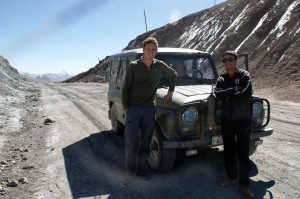 |
| On the road from Murghab to Osh – Joe’s smile is a bit forced |
From Murghab, we hired the aforementioned bloodthirsty Kyrgyz man with the help of a 12 year old who seemed to run our guest house (and was the only one who spoke English). He took us over the border to Osh for about $100, which covered the cigarette boxes which smoothed our way with the border guards.
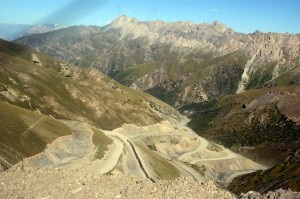 |
| The road through Kyrgyzstan |
From Osh, we took a series of shared taxis back to Khojand, also known as ‘furthest Alexandria’ – the last city that Alexander the Great founded, if not the furthest east he traveled. From Khojand we took a flight (booked on the day of) back to Dushanbe to get our flight out.
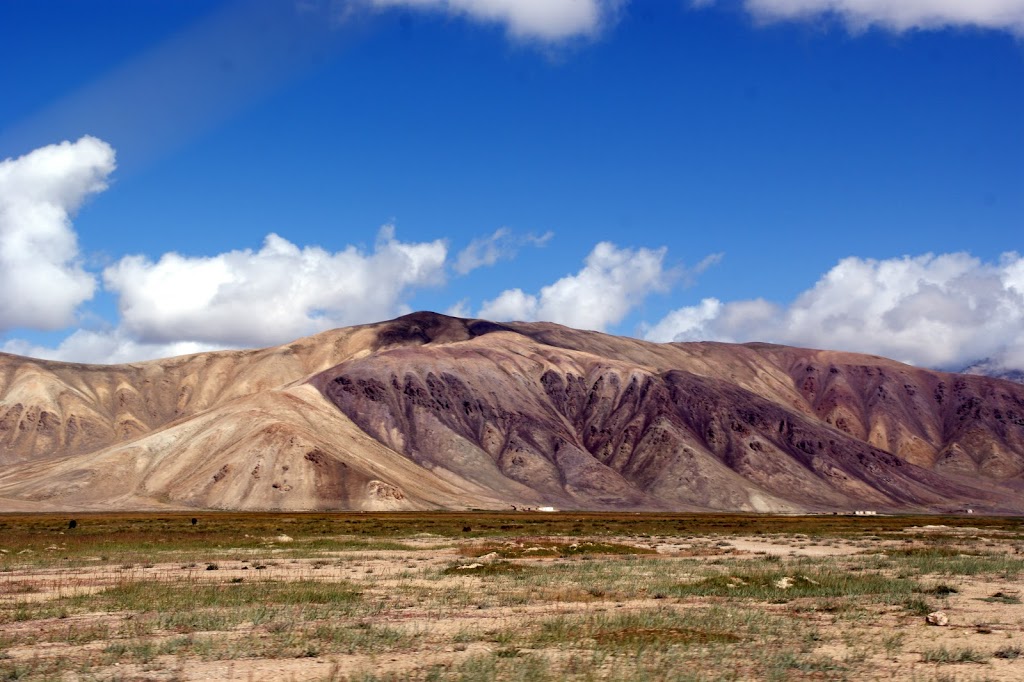
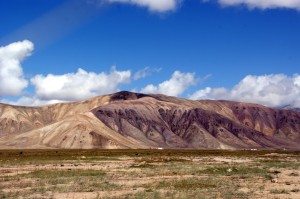


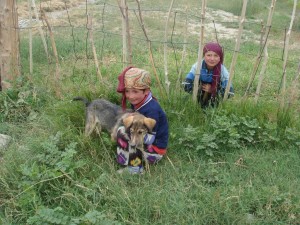
great entry. Truly fantastic scenery. It seems that the transportation network there is so flimsy and informal. Was it easy to get around aside from the occasional moral crisis? Also, the Oxus flows FROM the Pamir Mtns TO the Aral. Actually, it dries up before getting there (http://en.wikipedia.org/wiki/Amu_Darya). Was Tajikistan an open and friendly place in general? PS Absurdistan is One of my favorites. “If Pushkin were alive today, he’d be a rapper.’
PSS I am also impressed how you manage to work full time, organize boat trips and other fun gatherings, and maintain this rock solid, better-than-99.8-percent-of-other-blogs-out-there blog. WOOBAH!
Thanks for the tip, I’ve changed the direction of the Oxus in the entry. And yes, it was easy to get around – to be honest the easiest independent travel experience I’ve ever had. Each driver we hired along the way took time to help us arrange the next leg of our journey, even if we were just two passengers in a six-man shared taxi. Tajik and Pamiri people are among the most open and giving I have met anywhere in my travels around the world.
And thanks for the kind words. You keep a pretty fine blog yourself – I’ve added it to my blogroll on the right.